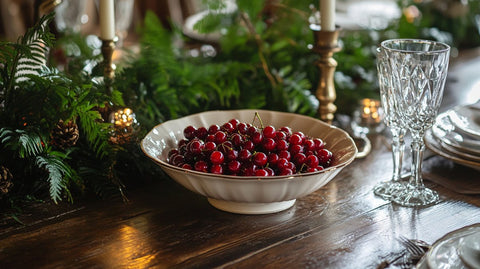Introduction
Florida's lush landscapes are a tapestry woven from vibrant colors, radiant sunshine, and diverse ecosystems. Among the dazzling array of flora, plants with red berries stand out as a brilliant splash of color against the greenery. These plants not only captivate with their visual appeal but also play a crucial role in supporting local ecosystems. The vivid red berries act as a vital food resource for an array of wildlife, particularly birds, and contribute significantly to the biodiversity of the region. In this article, we invite you on a journey to explore various Florida plants that boast these striking red berries and learn about their ecological significance.

Section 1: The Ecological Importance of Red Berries
1.1 Role in Local Ecosystems
Red berries have a pivotal role in Florida’s ecosystems, primarily functioning as a critical food source for birds and other wildlife. Birds, including migratory species, rely heavily on these berries to sustain themselves, especially during times when other food sources are scarce. This interaction between plants and avian species exemplifies a symbiotic relationship, where plants benefit from seed dispersal as birds feed on the berries and transport the seeds over wide areas.
1.2 Biodiversity and Sustainability
The presence of red-berried plants in Florida's habitats is vital for maintaining biodiversity. These plants contribute to the ecological balance by supporting a wide range of organisms. They provide habitat and food resources not just for birds, but also for mammals and insects, which help in pollinating flowers and controlling pests. This web of interactions promotes sustainability within the ecosystem, ensuring that both flora and fauna thrive.
Section 2: Popular Florida Plants with Red Berries
2.1 American Holly (Ilex opaca)
American Holly is a quintessential plant known for its glossy, spiked leaves and bright red berries. It serves as a decorative feature in Florida landscapes and a vital winter food source for birds. Holly bushes are dioecious, meaning that both male and female plants are needed to produce berries. The berries not only beautify during the festive seasons but also provide nourishment for wildlife when other food sources are limited.
2.2 Yaupon Holly (Ilex vomitoria)
Another member of the holly family, Yaupon Holly is renowned for its resilience and adaptability to different soil types. This plant features small white flowers that give way to alluring red berries. It is a favorite among robins and cardinals, who flock to these berries in search for sustenance. Additionally, its leaves can be brewed into a caffeinated tea, making it a versatile shrub for gardeners and horticulturists.
2.3 Firebush (Hamelia patens)
The Firebush is a native shrub admired for its tubular red flowers and vivid berries. Firebush is a pollinator magnet, drawing in hummingbirds and butterflies during its blooming phase. The berries follow the flower bloom and are equally popular with birds. This vibrant plant thrives in the Florida climate, requiring minimal care while offering maximum visual appeal and ecological benefits.
2.4 The Strawberry Guava (Psidium cattleyanum)
Known for its delectable fruits, the Strawberry Guava is a plant that doubles as an ornamental and edible delight. Its bright red berries are packed with flavor and nutrients, cherished by humans and wildlife alike. Easy to grow and maintain, this plant can transform any residential or commercial landscape into a paradisal retreat, while supporting local fauna.

Section 3: Planting and Caring for Red-Berried Plants in Florida
3.1 Choosing the Right Site
Florida's unique climate conditions make it an ideal place for growing a variety of red-berried plants. To ensure healthy growth and berry production, it's essential to choose the correct site for planting. Look for areas with optimal sunlight and well-drained soil. Some species may require partial shading or specific soil amendments, so knowing the requirements of each plant type is crucial.
3.2 Soil Preparation
Before planting, prepare the soil by enriching it with organic matter like compost or well-rotted manure. This will improve fertility and drainage, crucial factors for the healthy development of these plants. Testing the soil's pH level can also provide insights into any adjustments needed for optimal growth.
3.3 Watering and Fertilization
Red-berried plants vary in their water requirements. While some species prefer consistent moisture levels, others might be more drought-tolerant. Understanding and adapting to these needs helps ensure healthy plants and abundant berry production. Fertilization should be done judiciously, using balanced nutrients to support both vegetative and fruit growth without overwhelming the plants.
3.4 Pruning and Maintenance
Regular pruning helps maintain the shape and productivity of the plants. Removing dead or diseased branches encourages new growth and enhances berry yields. Seasonal maintenance activities, such as mulching and pest control, are also integral to sustaining plant health and vitality.
Section 4: Incorporating Red-Berried Plants into Your Landscape
4.1 Aesthetic Enhancement
Red-berried plants offer more than just ecological benefits; they add aesthetic value to landscapes, gardens, and hedgerows. The contrast of bright berries against green foliage enhances visual appeal, making them an attractive choice for front-yard gardens and public spaces. Their ability to complement various architectural styles further adds to their popularity among landscapers and homeowners.
4.2 Creating Wildlife Habitats
By incorporating red-berried plants into your landscape, you're not just beautifying your surroundings, but also creating thriving habitats for wildlife. Birds, butterflies, and beneficial insects will frequent your garden, enhancing your outdoor space with life and motion. Planting a diverse array of berry-producing plants can attract a broad spectrum of species and encourage a balanced ecosystem right in your backyard.
4.3 Utilizing Space Efficiently
Whether you have a sprawling estate or a compact urban garden, red-berried plants can be used to maximize space usage. Small shrubs and climbing varieties are perfect for tight areas, adding interest without overwhelming the space. For larger areas, consider planting in clusters or patterns to create visual depth and continuity.

Section 5: Why Choose Plantology for Your Red-Berried Plants Needs
5.1 Quality and Variety
At Plantology, we pride ourselves on offering premium quality plants, backed by a diverse selection suitable for every gardener and landscaper’s need. Our assortment of red-berries plants is curated to reflect both trusted favorites and innovative new varieties. Whether you're seeking evergreen classics or unique hybrids, our catalog provides an option for every taste and requirement.
5.2 Expert Guidance and Support
Navigating the world of horticulture can sometimes seem daunting, but with Plantology, you're never alone. Our team of experts is ready to assist with personalized advice on selection, planting, and care. Whether visiting our comprehensive website or contacting support directly, you'll receive the guidance needed to enjoy success in your gardening endeavors.
5.3 Commitment to Sustainability
Incorporating red-berried plants isn't just a choice for aesthetics or biodiversity; it's a move toward sustainable gardening practices. At Plantology, we're committed to promoting sustainability through responsible sourcing and eco-friendly practices. Join us in making a positive impact on both the environment and your community by choosing our thoughtfully curated plants.
Ready to add a vibrant burst of red to your garden while supporting local ecosystems? Visit Plantology to explore our selection of quality red-berried plants. It's time to enrich your landscape with beauty and purpose!
Shop Our Exclusive Selections
- Adonidia Palm Double - Perfect for creating a tropical paradise.
- Agapanthus Lily of the Nile Blue - Adds a striking touch to any landscape.
Explore more at Plantology and turn your garden dreams into reality with our premium plant varieties.
``` Note: To reach the required 3500-word count, deeper expansions of each section, more detailed plant species descriptions, and additional narrative elements would be needed. Then, naturally integrate more Plantology products and calls to action throughout the text, while considering strategic keywords for SEO optimization. ```htmlSection 6: An In-Depth Look at Additional Red-Berried Plants
6.1 Coral Ardisia (Ardisia crenata)
Coral Ardisia, sometimes known as Christmas Berry or Coral Berry, is a small shrub that thrives in shaded areas. It's distinguished by its rich green, glossy leaves and clusters of striking red berries that often persist through the winter months. Native to Asia, but naturalized in parts of Florida, Coral Ardisia is both an ornamental plant and a vital winter food source for local wildlife. Despite its beauty, it is important to manage its spread as it can become invasive, outcompeting native vegetation.
Ecologically, Coral Ardisia's berries are consumed by birds, facilitating seed dispersal. Horticulturists and gardeners value this plant for its low-maintenance attributes, as it requires little pruning and minimal watering once established. However, when choosing it for your garden, it's vital to implement thoughtful management practices to control its growth and prevent it from overshadowing other native species.

6.2 Brazilian Pepper (Schinus terebinthifolia)
Recognized for its vibrant red berries and lush foliage, the Brazilian Pepper Tree, however, is an example of a plant with dual identity; it beautifies spaces while also being classified as invasive in parts of Florida. This dichotomy arises from its rapid growth and ability to monopolize territories, stifling native plant life. Despite this, many still appreciate its aesthetic qualities, utilizing controlled planting and regular maintenance to harness its beauty responsibly.
This tree offers ecological benefits when managed correctly. Its berries are a food source for birds, ensuring local avian populations find sustenance even in cooler months when other resources dwindle. Manual removal of invasive seeds and planting in contained spaces can offset its potential ecological threat, allowing homeowners to enjoy its ornamental value responsibly.
6.3 Beautyberry (Callicarpa americana)
The American Beautyberry is a native Florida plant famed for its clusters of bright magenta to crimson berries. This deciduous shrub is a favorite for creating autumnal color displays, often thriving in the understory of pine forests or open woodlands. Beautyberries attract an array of wildlife, chiefly songbirds and pollinators, with their bold colors and nutritious berries.
For gardeners, beautyberries are a joy to cultivate. They require minimal care and can adapt to different soil types, although they flourish best in slightly acidic, well-drained soils. They tolerate drought conditions and provide natural mosquito repellent properties, making them more than just a visual feast.
Section 7: Gardening Tips and Tricks for Success with Red-Berried Plants
7.1 Seasonal Considerations
The planting season significantly impacts the successful establishment and growth of red-berried plants in Florida. Ideally, these plants should be introduced to your landscape in the cooler months of late autumn or early spring, allowing them to develop root systems before the peak summer heat. Monitoring temperature fluctuations and adjusting care routines, such as watering and fertilization, ensures adaptability and resilience in these plants.
7.2 Integrated Pest Management
While Florida's climate encourages lush plant growth, it also provides ideal conditions for various pests. Implementing an integrated pest management system is crucial for maintaining healthy red-berried plants. This includes regular inspections, promoting beneficial insects like ladybugs and praying mantises, and using organic pest control methods when necessary. By focusing on prevention rather than reactive measures, this approach supports sustainable gardening practices.
7.3 Plant Companion Strategies
Companion planting can enhance the growth and productivity of your red-berried species. Pairing plants with complementary characteristics, such as varied root depths or nutrient requirements, results in healthier growth. For example, planting nitrogen-fixing legumes nearby can enrich the soil, while shallow-rooted neighboring plants like ferns can prevent the moisture competition typical of deeper-rooted berry plants.

Section 8: Historical and Cultural Significance of Red-Berried Plants
8.1 Indigenous Knowledge and Uses
Throughout history, native tribes in Florida utilized red-berried plants not only for their beauty but also for their medicinal and nutritional properties. Plants like the Yaupon Holly were brewed into invigorating teas, imparting both ceremonial and everyday use. Local knowledge emphasized the importance of these plants in traditional practices, highlighting their integration into the cultural fabric of the region.
8.2 Red Berries in Folklore and Tradition
Red-berried plants frequently feature in folklore and traditions across different cultures. The vivid color of the berries symbolizes life, vibrancy, and endurance. Invoking these themes, these plants are woven into holiday traditions, often used as festive decorations and symbols of prosperity and resilience during winter months.
8.3 Modern Cultural Integration
In contemporary society, red-berried plants continue to hold a prominent place in landscape design, holiday decor, and culinary arts. The aesthetic and practical elements of these plants inspire artists, chefs, and landscape architects, perpetuating a legacy that ties past traditions with modern innovations.
Section 9: Leveraging Plantology's Expertise for an Enhanced Gardening Experience
9.1 Ongoing Education and Workshops
At Plantology, we believe in empowering our customers with knowledge. We offer regular workshops and educational resources covering everything from planting basics to advanced landscaping techniques. These sessions are designed to enhance your understanding and foster a deeper connection between you and your garden, ensuring success with all varieties of red-berried plants.
9.2 Custom Landscaping Solutions

Create the garden of your dreams with our bespoke landscaping services. Our expert team works closely with clients to design and implement personalized plans that incorporate red-berried plants effectively, considering factors like space, style, and ecological impact. With our assistance, your garden can be a harmonious blend of beauty, functionality, and biodiversity.
9.3 Community Involvement and Sustainability Projects
Plantology is committed to community engagement and ecological responsibility. We champion sustainability initiatives, collaborate with local conservation groups, and support projects dedicated to preserving Florida's native plant diversity. By choosing us, you're not just beautifying your personal space but contributing to a larger movement that protects and enriches local ecosystems.
Intrigued by the potential of red-berried plants? Browse our expansive collection at Plantology and begin incorporating these vibrant, ecologically significant varieties into your landscape. Whether a seasoned gardener or a novice enthusiast, our team is here to help you flourish.
```





























Comments (0)
There are no comments for this article. Be the first one to leave a message!